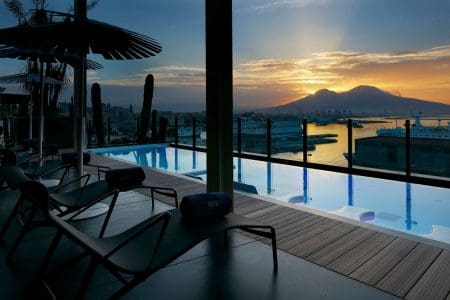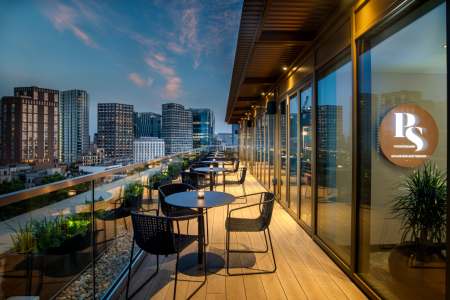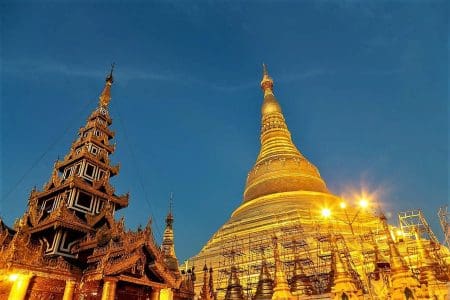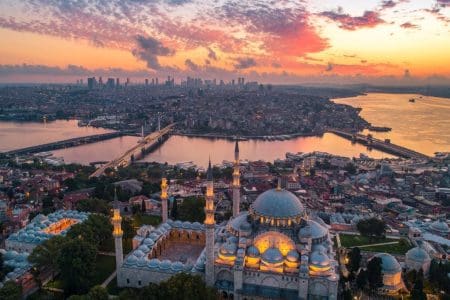Roger Hermiston and Eileen Wise stay at Il Relais Castelvecchio while enjoying a Verona city break in Italy’s most pleasant city.
With its majestic Roman amphitheatre hosting spectacular floodlit opera, its pink-hued medieval streets flanked by houses with beautiful flower-laden balconies, and its churches decorated with the finest Renaissance art, Verona can lay claim to the title of Italy’s loveliest city.
We journeyed there in early autumn, a little late for the Verona opera season but as good a time as any with the crowds thinning, a wine festival to enjoy, and the temperature still warm.
A Pleasant Verona City Break
Verona’s glories have fired the imagination of history’s greatest writers. The Roman poet Catullus is amongst the city’s famous sons, Dante did some of his best work in exile here, and the great German writer Goethe was inspired by the ancient trees in the gardens of one of the city’s finest palazzos.
The English connection is of course known famously through Shakespeare, who set two of his plays here – the tragedy Romeo and Juliet and subsequent comedy Two Gentlemen of Verona. But The Bard never actually set foot in the city, unlike Charles Dickens, who stayed here for a couple of nights in 1844.
The great novelist’s enthusiastic verdict would chime with our own reflections after a three-night stay. ‘Pleasant Verona! With its beautiful old palaces … and stately balustraded galleries. With its Roman gates, still spanning the fair street, and casting, on the sunlight of today, the shade of fifteen hundred years ago … with its fast-rushing river, picturesque old bridge, waving cypresses and prospect so delightful! Pleasant Verona!’
Trust the old master to paint the cityscape so vividly and accurately. And in truth, as we walked around – and this is very much the perfect walking city – not an awful lot seems to have altered in the city’s architecture since Dickens walked the streets nearly two hundred years ago. Verona’s timeless charm is its greatest asset.
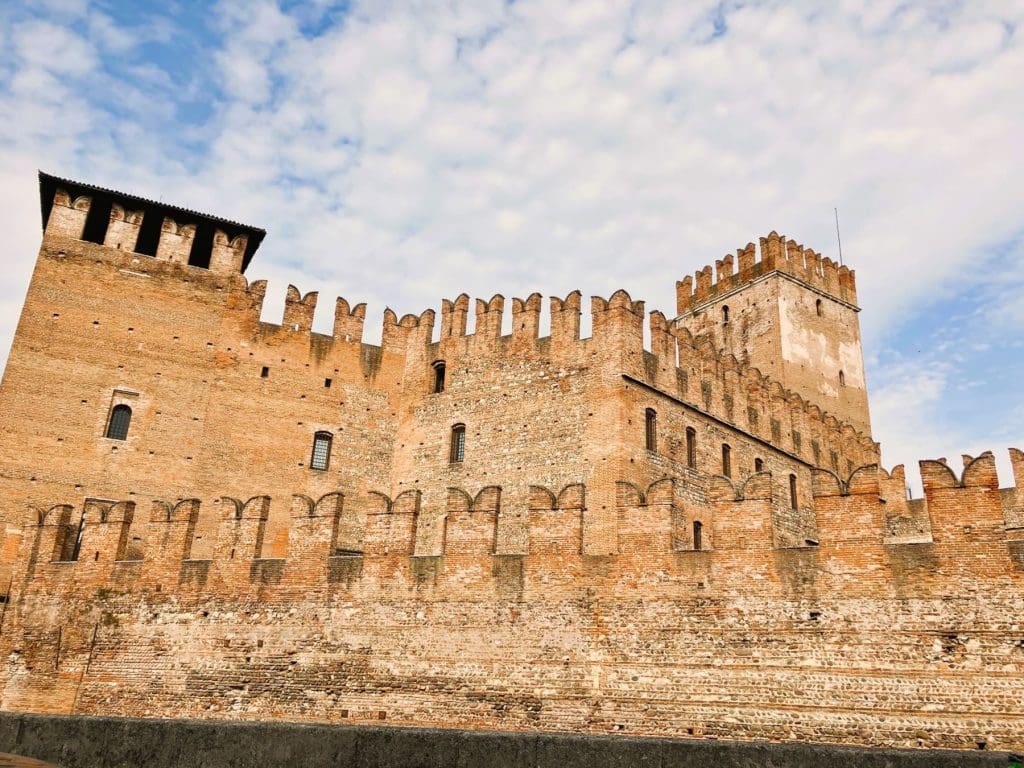
Il Relais Castelvecchio
Our visit to this pearl of the Veneto was greatly enhanced by our stay at one of the finest boutique hotels we have come across – Il Relais, set on the first floor of the 19th century Palazzo Tommasi and overlooking the walls of Castelvecchio, the massive Gothic castle/fortress constructed by the Scaliger family who ruled this city in the Middle Ages.
Strictly speaking Il Relais is a bed and breakfast establishment – but dinner is available on the floor below at the superb Locanda di Castelvecchio restaurant, which has close links with, but is independent of, Il Relais.
What makes Il Relais stand out from many other attractive boutique hotels we have visited is a combination of great room comfort, aesthetic pleasure in its remarkable interior design, and the excellent service of a family-run hotel.
Il Relais has just four rooms – ours, No. 2, looks out directly at the old castle across the street, while also giving an excellent view from its verandah down the length of Corso Castelvecchio, which leads to the heart of the city. The essentials were well covered – a supremely comfortable king-sized bed, and a spacious bathroom covered in local red marble with a vast walk-in shower. We had not one but two wardrobes, and a television artfully concealed behind a mirror.
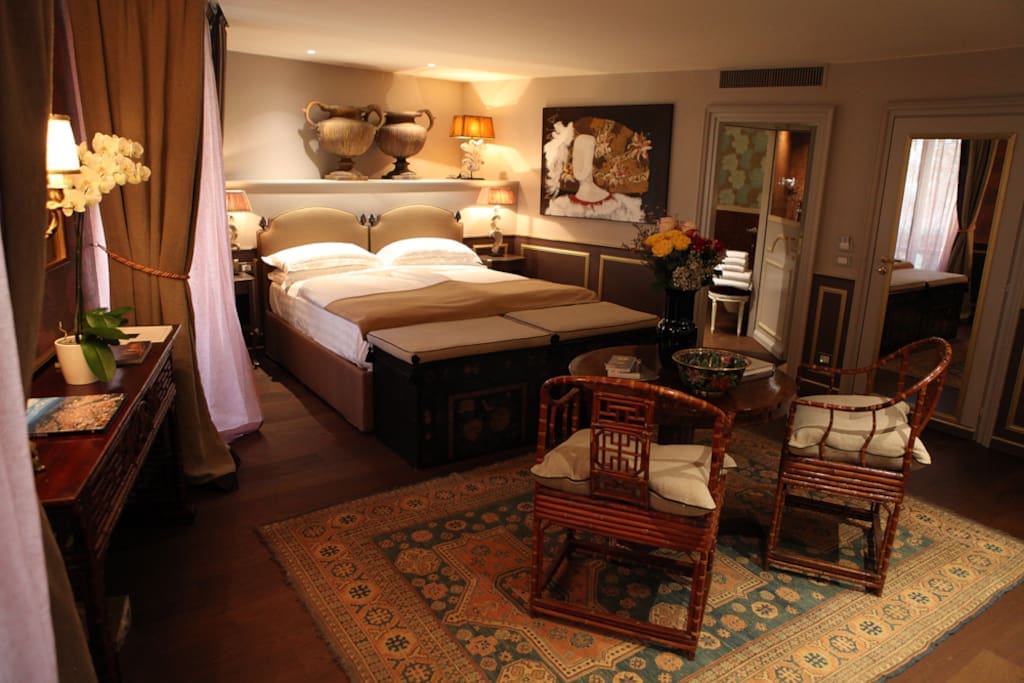 But the room’s unique character comes from its delightful, eclectic mix of furniture and objets d’art, in keeping with its heritage as an elegant 19th century Veronese townhouse. In the centre, the wooden floor is covered with a lovely antique rug; in one corner a small velvet sofa stands below a grouping of nine intriguing Chinese prints; a bronze cherub candelabra adorns a writing table by another wall; two enormous Roman-like urns stand on the ledge above the bed.
But the room’s unique character comes from its delightful, eclectic mix of furniture and objets d’art, in keeping with its heritage as an elegant 19th century Veronese townhouse. In the centre, the wooden floor is covered with a lovely antique rug; in one corner a small velvet sofa stands below a grouping of nine intriguing Chinese prints; a bronze cherub candelabra adorns a writing table by another wall; two enormous Roman-like urns stand on the ledge above the bed.
All these objects and more – all the design of the owner’s father – makes for a rich visual experience to add to the comforts of a luxurious room. Down the corridor lined with classical busts and antique tables, we made our way to breakfast in a delightful little room with prints of colourful birds all around the walls. There we were served a fortifying breakfast of fresh fruit, yoghurt, cream croissant, biscotti, prosciutto, cheese and coffee.
In attendance in the mornings – and on call if we needed them – were our charming managers Federica and Niami, who welcomed us as if into their own home. They were full of excellent suggestions about what we could do during our stay, from historic sites to Verona’s best restaurants.
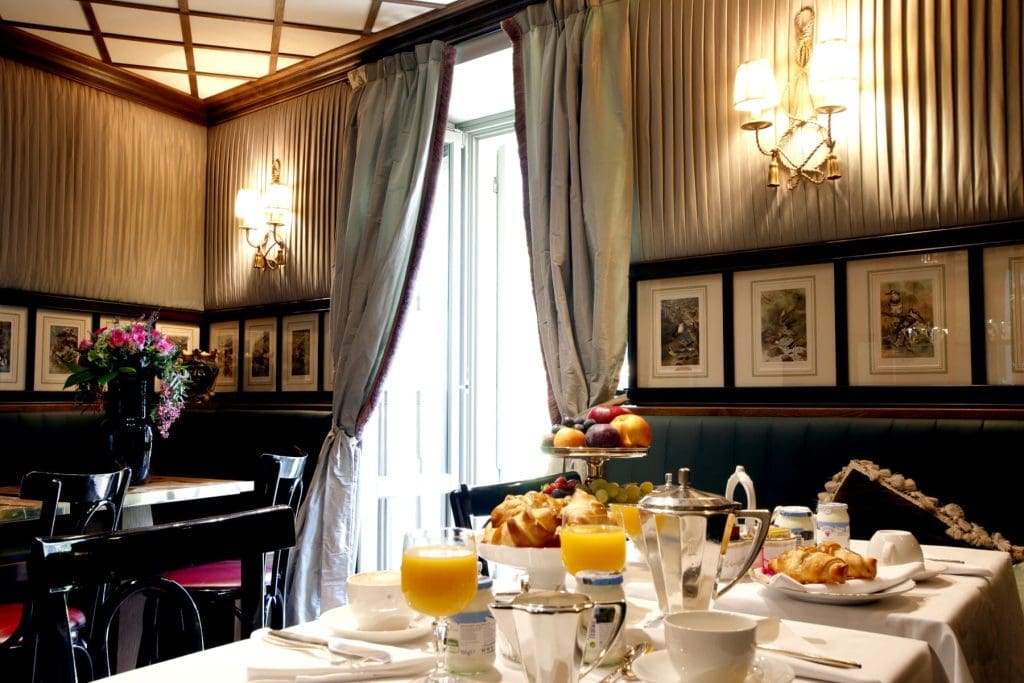
We did try one of their recommendations, Beluga, a fish restaurant just a five-minute stroll away, which was more than satisfactory. But for our other two evening meals we went no further than the floor below, to Il Relais’s sister establishment, Ristorante Locanda di Castelvecchio.
Locanda di Castelvecchio
It’s a site with a rich history. Here in the 1700s stood a pharmacy, before it was recast as a delicatessen in 1831 (the oldest of its type in the city), remaining as such until the year 2000. Armando Bodin, entrepreneur and chef, then transformed it into what it is now – an undisputed institution on Verona’s gastronomic scene.
Locanda di Castelvecchio is a stunning looking restaurant, its décor marrying the styles of the 19th century with art deco elements plus some 1960 touches from the Italian designer Fornasetti. Its crisp white tablecloths are decked out with gleaming vintage crockery, and its dark wood-paneled walls host an eclectic collection of historic portrait paintings.
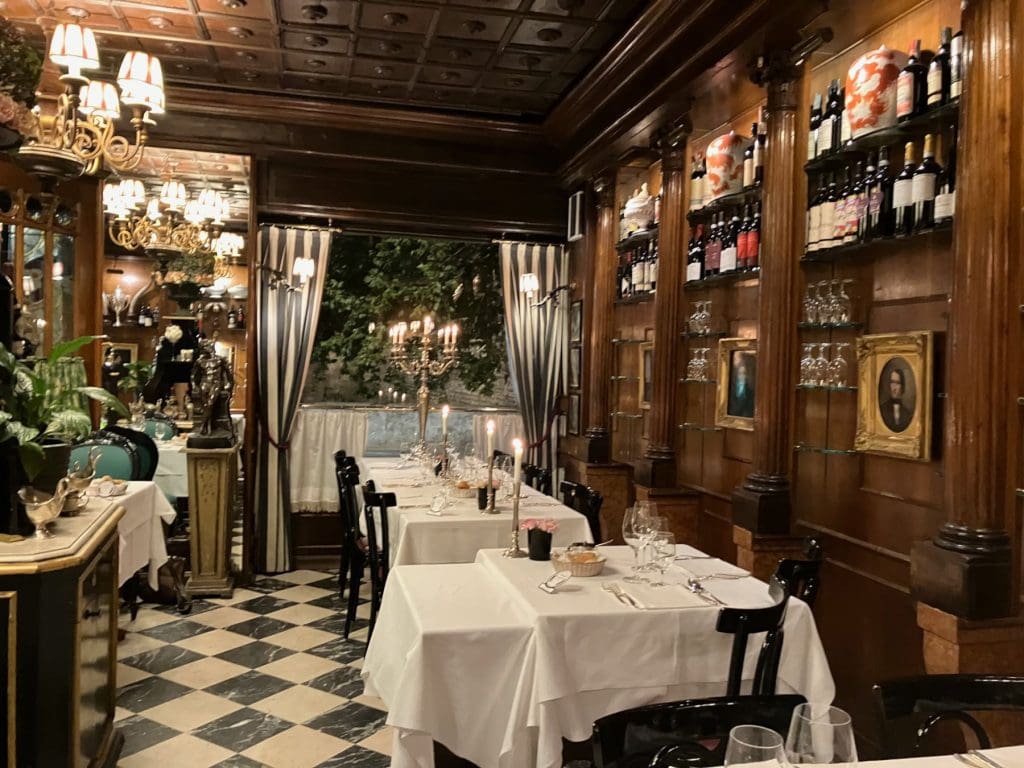
The highlight of the menu is undoubtedly the trolley of roasts, which is wheeled to the table (a similar experience to the old Simpsons on the Strand in London) with great ceremony and the meats, served with traditional Veronese peara sauce, then carved with much aplomb.
We enjoyed the spectacle and the showmanship of the waiters, but opted instead for other alluring dishes, including the home-made fettucine with four sauces, tomato, ragout, livers and vegetarian, and the classic risotto with amarone (the wine of the region).
The food was delicious, the accompanying white wine excellent, and for both our visits we were looked after with great elan by Stefano, who guided us expertly through the choices and regaled us with stories from the restaurant’s history.
Museo di Castelvecchio
There was so much we wanted to experience during our stay, and we would clock up six miles each day on our perambulations around the city. Armed with our Verona Card (for €28 free admission over three days to a host of museums and churches), our first stop was just across the road at the Museo di Castelvecchio, scene of possibly the biggest art heist to be carried out in Italy in 2015.
Here, through a succession of chambers, courtyards and walkways, we inspected a splendid collection of paintings and frescos from the Renaissance greats such as Pisanello and Bellini, and also admired some fine medieval sculpture. One of the latter was an imposing statue of St Catherine of Alexandria, martyred in the 4th century, who – we were intrigued to learn, on the eve of Bonfire Night – gave her name to the Catherine Wheel, after the instrument of torture she was forced to endure.
Verona City Break: Verona Arena
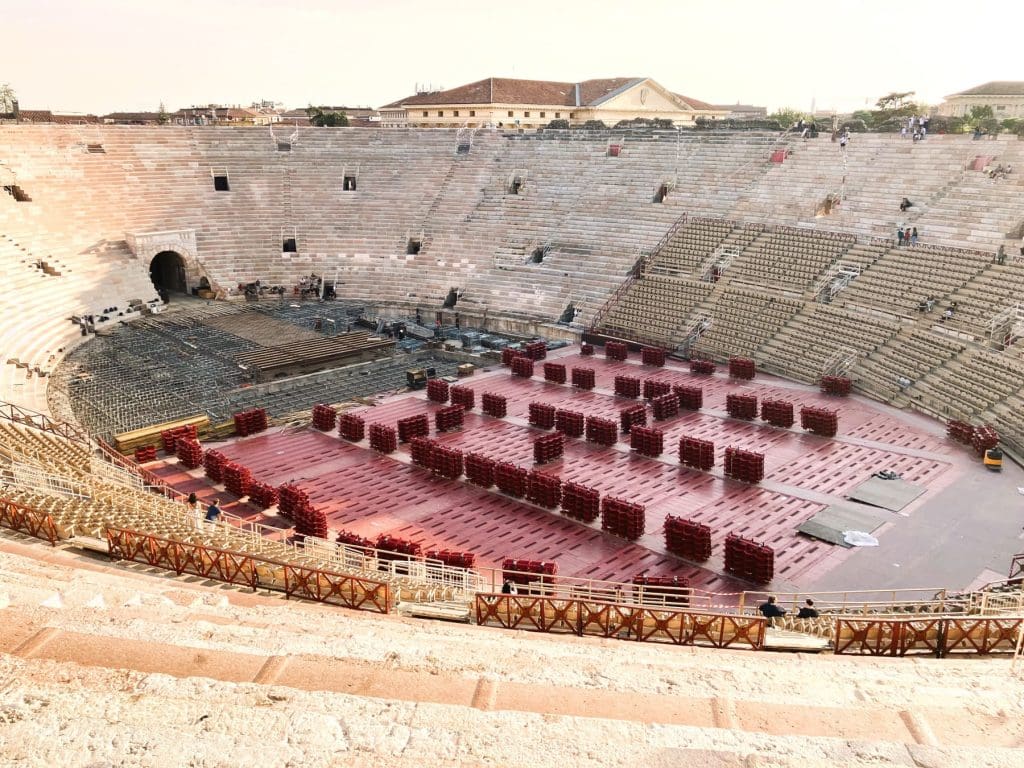
In Verona’s famous Arena – the third largest of all the Roman amphitheatres from the first century AD – we could imagine what it was like when crowds of twenty thousand flocked to watch the gladiatorial contests and the unequal battles between man and beast. We climbed to the very top to gaze down on the vast space, and it seemed appropriate to declaim Maximus Decimus Meridus’s (aka Russell Crowe) famous speech in Gladiator! We would certainly want to return to witness a night-time opera in such imposing surroundings.
In Piazza Bra, alongside the Arena, we stumbled upon a participant in Verona’s Festival Balconscenico, in which amateur artists are encouraged to perform from the city’s many balconies to the crowds below. This performer was singing and playing a more than creditable version of Sting’s “Message in a Bottle’. He looked like The Police frontman, too, and for a while we were almost convinced it was the great man himself (who does spend time in Verona). Our Facebook posting of the concert convinced our friends we had indeed witnessed a Sting mini-concert!
There was more musical delight the following day while we were sampling the local produce in the 9th Hostaria – Verona’s annual wine and harvest festival. Wine glasses in hand, we followed the drifting sound of music out of Piazza dei Signori and found ourselves in a delightful little square where a young artist was performing a captivating version of Ed Sheeran’s ‘The Shape of You’, with a keyboard strapped around her shoulders. Her name was Felicity Lucchesi, well-known in these parts, and her audience swelled as she went through her repertoire, including a soulful version of Leonard Cohen’s ‘Hallelujah’.
In Verona you should do two things – pay homage to the family who shaped this city for several centuries and built its wealth and prestige, and follow in the footsteps of the imagination of the man who has given the city its romantic reputation.
Juliet’s Balcony Verona
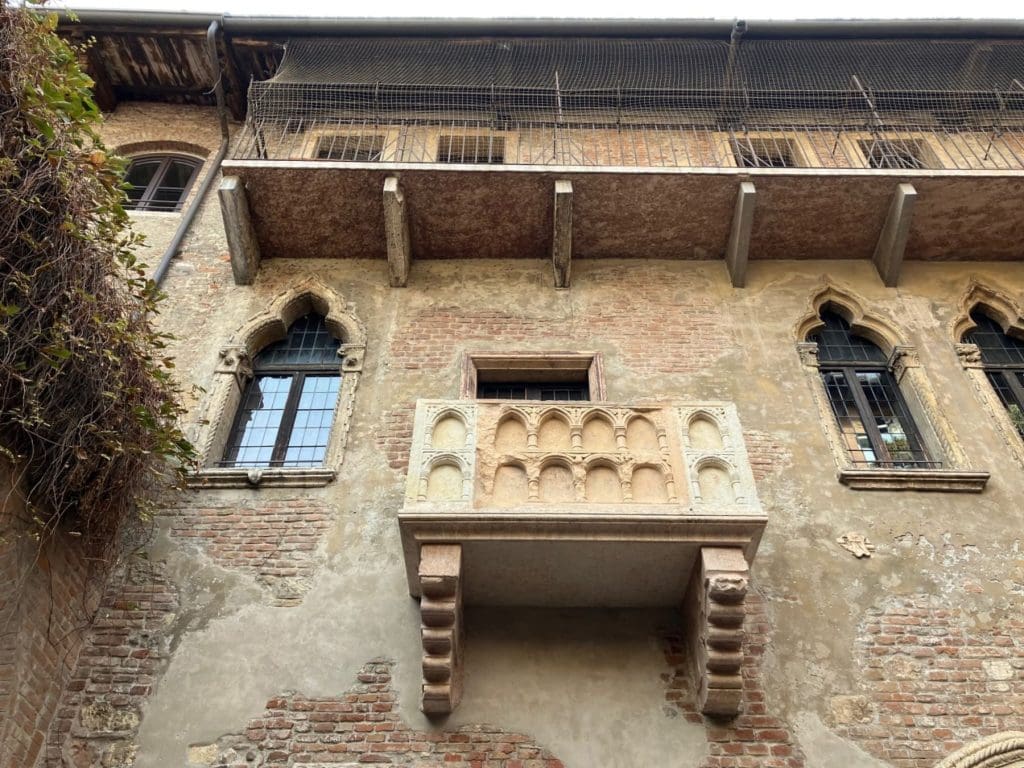
Imagination because no evidence exists that Shakespeare ever came to Verona; but his fictional story of the star-crossed lovers has helped the city’s tourist industry immeasurably over the centuries. Even Dickens read Romeo and Juliet while he visited Verona, and like everyone else made the traditional pilgrimage to ‘Juliet’s balcony’ and ‘Juliet’s tomb’.
On a Sunday Casa di Giuletta (‘Juliet’s House’), with the ‘O Romeo, Romeo, wherefore art thou Romeo’ balcony, was so heaving with visitors that we couldn’t get near it, so we returned on the Monday when it was much quieter. The balcony itself was picturesque enough, and we watched a succession of teenage girls line up to touch the breast of the statue of the fictional lady, an act supposed to bring luck in love.
Of real substance is the story of the Scaligers, the ruling family of Verona from 1262 to 1387. Not far from Juliet’s balcony is the 12th century church of Santa Maria Antica, whose outside compound houses the Arche Scaligere (‘tombs of the Scaligeri’), which are among the finest funerary monuments in Italy.
The Scaligers were ruthless power-seekers, but great patrons of the arts. There are nine of their tombs here, the most ostentatious being that of Cansigornio, Lord of Verona from 1359-1375. He was less powerful than his ancestors but what he couldn’t achieve in life he made up with this impressive monument in death, glorifying himself on his tomb-tabernacle as a monarch, surrounding his image with saints, warriors and kings.
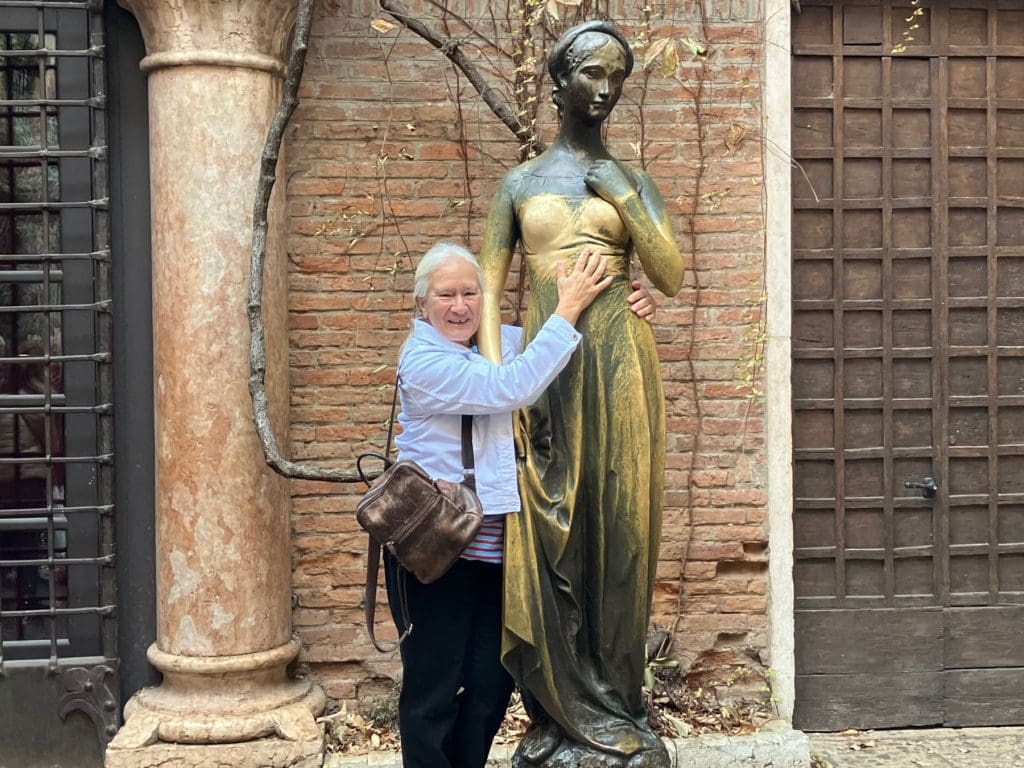
We crossed the fast-flowing River Adige to take a look at perhaps Verona’s finest palazzo, Giusti, and its splendid Renaissance gardens whose huge cypress trees Goethe had so admired. The Giusti family were in residence here from the 16th century right up until the end of the Second World War, and the palazzo is opulent and stylish. Of all the rooms perhaps the most impressive was The Red Room, taking its name from the luxurious red Chinese silk that adorns its walls. This was the drawing room of Eleonora Giusti, the last family member to live in the palazzo.
Verona Duomo
Crossing back over the river on our way home, we stopped in on the Duomo where the third musical treat of our stay awaited us. We were lucky to stumble upon a performance by the cathedral choir, lovely voices coming from somewhere up high up in a gallery (we couldn’t see the choristers) and resounding to an appreciative congregation below.
Dating from the 12th century, the cathedral is a delight, featuring a series of small chapels, arched ceilings and stunning sculptures and frescoes. The Baptistery, with its massive octagonal font, is a masterpiece of Romanesque sculpture, attributed to the studio of the sculptor Brioloto.
It was time to call a halt to our Verona city break and take a train north to the Dolomites for the next leg of our mini-break. Next time we will return in the opera season. ‘Pleasant Verona’ indeed – a stimulating, relaxing intimate city.
Il Relais
This hotel is the perfect place to stay on your Verona City Break. For further information, visit www.ilrelais.com.
Verona City Break
For more inspiration for the things to do in Verona Italy, visit: VisitVerona.it
